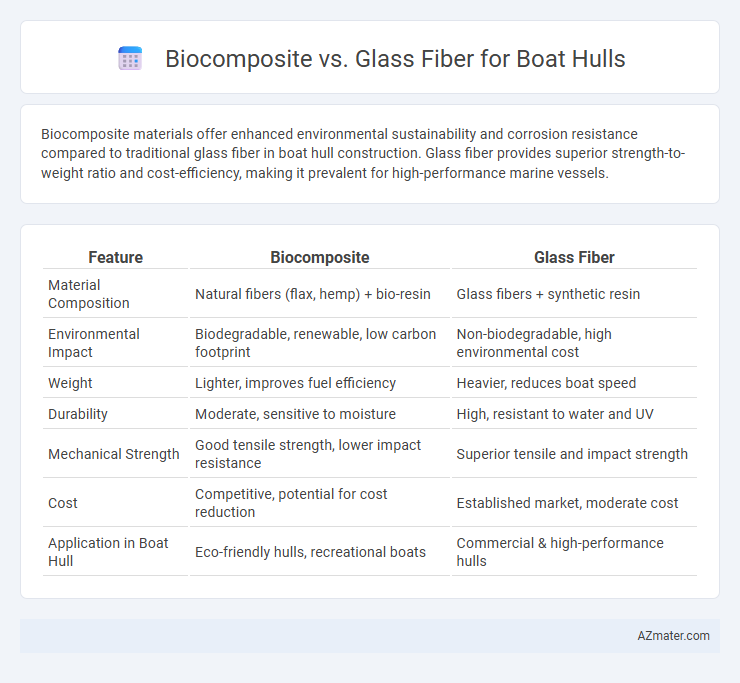Biocomposite materials offer enhanced environmental sustainability and corrosion resistance compared to traditional glass fiber in boat hull construction. Glass fiber provides superior strength-to-weight ratio and cost-efficiency, making it prevalent for high-performance marine vessels.
Table of Comparison
| Feature | Biocomposite | Glass Fiber |
|---|---|---|
| Material Composition | Natural fibers (flax, hemp) + bio-resin | Glass fibers + synthetic resin |
| Environmental Impact | Biodegradable, renewable, low carbon footprint | Non-biodegradable, high environmental cost |
| Weight | Lighter, improves fuel efficiency | Heavier, reduces boat speed |
| Durability | Moderate, sensitive to moisture | High, resistant to water and UV |
| Mechanical Strength | Good tensile strength, lower impact resistance | Superior tensile and impact strength |
| Cost | Competitive, potential for cost reduction | Established market, moderate cost |
| Application in Boat Hull | Eco-friendly hulls, recreational boats | Commercial & high-performance hulls |
Introduction to Boat Hull Materials
Boat hull materials predominantly include biocomposites and glass fiber composites, each offering unique advantages in marine applications. Biocomposites combine natural fibers such as flax or hemp with resin matrices, providing enhanced sustainability and reduced environmental impact compared to traditional glass fiber reinforced polymers. Glass fiber composites remain favored for their high strength-to-weight ratio, durability, and resistance to marine corrosion, making them a standard choice for boat hull construction across recreational and commercial vessels.
Overview of Biocomposites
Biocomposites for boat hulls consist of natural fibers such as flax, hemp, or jute embedded in a biodegradable or bio-based resin matrix, offering a sustainable alternative to traditional glass fiber composites. These materials provide benefits like reduced environmental impact, lower weight, and improved vibration damping, enhancing overall boat performance and fuel efficiency. Advances in biocomposite technology have increased their mechanical strength and durability, making them increasingly competitive with conventional glass fiber-reinforced polymers in marine applications.
Glass Fiber in Marine Applications
Glass fiber remains a dominant material in marine applications due to its exceptional strength-to-weight ratio, corrosion resistance, and ease of fabrication for boat hulls. It provides superior durability against harsh ocean environments, including saltwater, UV exposure, and mechanical impacts, making it ideal for long-lasting marine vessels. The widespread availability and cost-effectiveness of glass fiber composites reinforce their preference over biocomposites for high-performance boat hull construction.
Strength and Durability Comparison
Biocomposite boat hulls offer comparable tensile strength to glass fiber composites while providing enhanced environmental benefits through biodegradable matrices and renewable fibers. Glass fiber remains superior in impact resistance and long-term durability against marine degradation such as UV exposure and saltwater corrosion. Advances in biocomposite resin formulations are closing the gap in durability, making biocomposites increasingly viable for sustainable boat hull applications.
Weight and Performance Factors
Biocomposite boat hulls offer a significant weight reduction compared to traditional glass fiber, improving fuel efficiency and maneuverability. Their enhanced strength-to-weight ratio delivers superior impact resistance and durability under marine conditions. Glass fiber remains favored for consistent performance and cost-effectiveness but often results in heavier hulls with slightly reduced speed and agility.
Environmental Impact and Sustainability
Biocomposite boat hulls significantly reduce environmental impact by utilizing natural fibers like flax or hemp combined with bio-based resins, resulting in lower carbon footprints and enhanced biodegradability compared to traditional glass fiber composites. Glass fiber hulls rely on energy-intensive production processes and non-biodegradable materials, contributing to higher greenhouse gas emissions and persistent marine waste problems. Sustainable boat construction increasingly favors biocomposites for their renewable sourcing, reduced toxicity, and improved recyclability, addressing critical lifecycle environmental concerns in marine industries.
Cost Analysis: Biocomposite vs Glass Fiber
Biocomposite boat hulls often present a higher initial material cost compared to traditional glass fiber due to the expense of natural fibers and bio-based resins. However, biocomposites may offer long-term savings through reduced environmental compliance costs and potential recyclability benefits. Glass fiber remains cost-effective in large-scale production with established supply chains, making it economically favorable for mass-produced hulls.
Manufacturing and Processing Techniques
Biocomposite boat hulls use natural fibers like flax or hemp combined with bio-resins, enabling eco-friendly manufacturing through techniques such as compression molding and vacuum infusion, which reduce energy consumption and waste. Glass fiber hulls rely on traditional wet lay-up and resin transfer molding processes, offering established scalability and durability but higher environmental impact due to synthetic materials and energy-intensive curing. Processing biocomposites often requires more precise control of moisture content and fiber orientation to ensure mechanical performance comparable to glass fiber composites.
Maintenance and Longevity
Biocomposite boat hulls offer superior resistance to corrosion and marine organism growth, reducing long-term maintenance compared to glass fiber hulls that often require regular antifouling treatments and repairs due to gelcoat cracking or osmosis. The biodegradable matrix in biocomposites enhances environmental sustainability while maintaining durability, whereas glass fiber hulls can suffer from delamination and structural degradation over time if not properly maintained. Longevity is typically higher in biocomposite hulls designed with advanced natural fibers and resins, providing extended lifespan with less frequent upkeep in marine environments.
Future Trends in Boat Hull Construction
Biocomposite materials are rapidly gaining traction in boat hull construction due to their sustainability, lightweight properties, and lower environmental impact compared to traditional glass fiber composites. Innovations in natural fiber reinforcements, such as flax and hemp, combined with bio-based resins are enhancing mechanical performance and durability, pushing biocomposites closer to parity with glass fiber in marine applications. Future trends emphasize circular economy principles, where recyclability and reduced carbon footprints drive research and adoption of biocomposite hulls, positioning them as a viable alternative for eco-conscious boat manufacturing.

Infographic: Biocomposite vs Glass Fiber for Boat Hull
 azmater.com
azmater.com